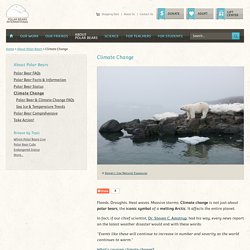

Matthew
The 20-Year-Old With a Plan to Rid the Sea of Plastic. The Ocean Cleanup, developing technologies to extract, prevent and intercept plastic pollution. Boyan Slat. “Human history is basically a list of things that couldn't be done, and then were done.” Boyan Slat (Delft, 1994) combines environmentalism, creativity and technology to tackle global issues of sustainability. Currently working on oceanic plastic pollution, he believes current prevention measures will have to be supplemented by active removal of plastics in order to succeed. “It will be very hard to convince everyone in the world to handle their plastics responsibly, but what we humans are very good in, is inventing technical solutions to our problems. And that’s what we’re doing.” Climate Change. Driving a car, using electricity to light and heat your home, and throwing away garbage all lead to greenhouse gas emissions.

You can reduce emissions through simple actions like changing a light bulb, powering down electronics, using less water, and recycling. This site provides more than 25 easy steps you can take at Home, School, the Office, and On the Road to protect the climate, reduce air pollution, and save money. Take action today! Small steps add up, if we all do our part. At Home Making a few small changes in your home and yard reduces greenhouse gas emissions and saves you money. Learn More » On the Road Burning gasoline and other fossil fuels releases carbon dioxide (CO2) and contributes to climate change. Learn More » What is Ocean Acidification? A pH unit is a measure of acidity ranging from 0-14.

The lower the value, the more acidic the environment. Becoming more acidic is a relative shift in pH to a lower value. Pteropod Limacina Helicina. Courtesy of Russ Hopcroft, UAF. Pteropod The Chemistry When carbon dioxide (CO2) is absorbed by seawater, chemical reactions occur that reduce seawater pH, carbonate ion concentration, and saturation states of biologically important calcium carbonate minerals. Since the beginning of the Industrial Revolution, the pH of surface ocean waters has fallen by 0.1 pH units. The Biological Impacts Ocean acidification is expected to impact ocean species to varying degrees. Pteropods The pteropod, or “sea butterfly”, is a tiny sea creature about the size of a small pea. Shellfish. Climate Change. Floods.

Droughts. Heat waves. Massive storms. Climate change is not just about polar bears, the iconic symbol of a melting Arctic. It affects the entire planet. In fact, if our chief scientist, Dr. "Events like these will continue to increase in number and severity as the world continues to warm. " What's causing climate change? What's causing climate change? Greenhouse gases (GHGs) in the atmosphere act like a blanket that keeps the earth warm. Other factors such as deforestation have added to the problem. Do scientists agree about climate change? The laws of physics dictate that the world will grow warmer and warmer as greenhouse gas concentrations rise. Are scientists still debating climate change?
The important point to remember is that natural fluctuations in the climate system will continue with global warming, but the baseline will climb higher and higher. And once we cross those thresholds, it will be bad news not only for polar bears—but countless other species, including humans. Climate Change Research. How We Showed the Oceans Could Clean Themselves - Boyan Slat on The Ocean Cleanup. High-Tech Trash. June is the wet season in Ghana, but here in Accra, the capital, the morning rain has ceased.

As the sun heats the humid air, pillars of black smoke begin to rise above the vast Agbogbloshie Market. I follow one plume toward its source, past lettuce and plantain vendors, past stalls of used tires, and through a clanging scrap market where hunched men bash on old alternators and engine blocks. Soon the muddy track is flanked by piles of old TVs, gutted computer cases, and smashed monitors heaped ten feet (three meters) high.
Beyond lies a field of fine ash speckled with glints of amber and green—the sharp broken bits of circuit boards. I can see now that the smoke issues not from one fire, but from many small blazes. Choking, I pull my shirt over my nose and approach a boy of about 15, his thin frame wreathed in smoke. People have always been proficient at making trash. Computers are hardly the only electronic hardware hounded by obsolescence. So what happens to all this junk? Mo'ne Davis. Ocean Pollution, Boyan Slat.